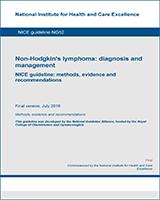All rights reserved. NICE copyright material can be downloaded for private research and study, and may be reproduced for educational and not-for-profit purposes. No reproduction by or for commercial organisations, or for commercial purposes, is allowed without the written permission of NICE.
NCBI Bookshelf. A service of the National Library of Medicine, National Institutes of Health.
Excerpt
Non-Hodgkin's lymphoma is the sixth most common cancer in the UK. There are many different subtypes of the disease, with markedly different clinical courses and requirements for therapy. Diagnosing non-Hodgkin's lymphoma and the precise subtype is challenging, and optimising the diagnostic process is central to improved management. Significant improvements in our understanding of the biology of non-Hodgkin's lymphoma have contributed to improved diagnosis and also allowed for more targeted therapies.
The treatment of non-Hodgkin's lymphoma has been a beacon for the development of specific treatment strategies (now applied to many other forms of cancer), but paradoxically there is a paucity of large randomised clinical trials to define best practice in treating the various subtypes. As a consequence there are considerable differences between centres and countries in the ways in which some subtypes of the disease are diagnosed and managed.
There have been some improvements in outcome for people with non-Hodgkin's lymphoma in the last decade, but these have been relatively modest and there is still a need for improvement. This is a rapidly developing field, with a number of new therapies proving to be exciting in initial studies. It is too soon, however, to judge their long-term impact, and ongoing assessment of these new agents compared with standard therapy will be needed.
This guideline aims to facilitate standardisation of practice in treating non-Hodgkin's lymphoma. But because of the rapid development of new therapies as a result of improved understanding of the biology of the disease, continual re-evaluation will be essential.
Contents
- Foreword
- Methodology
- Research recommendations
- 1. Epidemiology
- 2. Diagnosis
- 3. Staging
- 4. Management
- 5. Patient information needs
- 6. Follow-up of DLBCL
- 7. Survivorship
- Appendices
- Appendix A. A cost-utility analysis of autologous and allogeneic transplantation for people with follicular lymphoma
- Appendix B. The role of immediate compared with deferred chemotherapy (watch and wait) in treating advanced asymptomatic follicular lymphoma
- Appendix C. Abbreviations
- Appendix D. Glossary
- Appendix E. Guideline Scope
- Appendix F. People and organisations involved in production of the guideline
- Appendix G. Full evidence review
- Appendix H. Findings of patient experience survey
- Appendix I. Search strategies
- Appendix J. Review Protocols
- Appendix K. Excluded health economic papers
This guideline was developed by the National Guideline Alliance, hosted by the Royal College of Obstetricians and Gynaecologists
Disclaimer: Healthcare professionals are expected to take NICE clinical guidelines fully into account when exercising their clinical judgement. However, the guidance does not override the responsibility of healthcare professionals to make decisions appropriate to the circumstances of each patient, in consultation with the patient and/or their guardian or carer.
- NLM CatalogRelated NLM Catalog Entries
- Review Non-Hodgkin's lymphoma.[Curr Probl Cancer. 1996]Review Non-Hodgkin's lymphoma.Smith MR. Curr Probl Cancer. 1996 Jan-Feb; 20(1):6-77.
- Review Hodgkin's lymphoma: evolving concepts with implications for practice.[Hematology Am Soc Hematol Educ...]Review Hodgkin's lymphoma: evolving concepts with implications for practice.Meyer RM, Ambinder RF, Stroobants S. Hematology Am Soc Hematol Educ Program. 2004; :184-202.
- Review Rituximab: a review of its use in non-Hodgkin's lymphoma and chronic lymphocytic leukaemia.[Drugs. 2003]Review Rituximab: a review of its use in non-Hodgkin's lymphoma and chronic lymphocytic leukaemia.Plosker GL, Figgitt DP. Drugs. 2003; 63(8):803-43.
- Review [Non-Hodgkin's lymphoma: biologic classification, diagnosis and treatment].[Gac Med Mex. 1998]Review [Non-Hodgkin's lymphoma: biologic classification, diagnosis and treatment].Jiménez-Zepeda VH, Jiménez-Zepeda RJ. Gac Med Mex. 1998 Jul-Aug; 134(4):443-63.
- Intensive treatment strategies in advanced-stage Hodgkin's lymphoma (HD9 and HD12): analysis of long-term survival in two randomised trials.[Lancet Haematol. 2018]Intensive treatment strategies in advanced-stage Hodgkin's lymphoma (HD9 and HD12): analysis of long-term survival in two randomised trials.von Tresckow B, Kreissl S, Goergen H, Bröckelmann PJ, Pabst T, Fridrik M, Rummel M, Jung W, Thiemer J, Sasse S, et al. Lancet Haematol. 2018 Oct; 5(10):e462-e473.
- Non-Hodgkin's Lymphoma: Diagnosis and ManagementNon-Hodgkin's Lymphoma: Diagnosis and Management
Your browsing activity is empty.
Activity recording is turned off.
See more...
